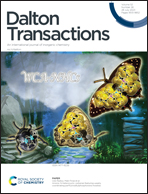Co(ii) complexes of tetraazamacrocycles appended with amide or hydroxypropyl groups as paraCEST agents†
Abstract
Co(II) complexes of 1,4,7,10-tetraazacyclododecane (CYCLEN) or 1,4,8,11-tetraazacyclotetradecane (CYCLAM) with 2-hydroxypropyl or carbamoylmethyl (amide) pendants are studied with the goal of developing paramagnetic chemical exchange saturation transfer (paraCEST) agents. Single-crystal X-ray diffraction studies show that two of the coordination cations with hexadentate ligands, [Co(DHP)]2+ and [Co(BABC)]2+, form six-coordinate complexes; whereas two CYCLEN-based complexes with potentially octadentate ligands, [Co(THP)]2+ and [Co(HPAC)]2+, are seven-coordinate with only three of the four pendant groups bound to the metal center. 1H NMR spectra of these complexes suggest that the six-coordinate complexes are present as a single isomer in aqueous solution. For the complexes which are seven-coordinate in the solid state, one is highly fluxional in aqueous solution on the NMR time scale ([Co(HPAC)]2+), whereas the NMR spectrum of [Co(THP)]2+ is consistent with an eight-coordinate complex with all pendants bound. Co(II) complexes of CYCLEN derivatives show CEST effects of low intensity that are assigned to NH or OH groups of the pendants. One complex, [Co(DHP)]2+, shows a highly-shifted CEST peak at 113 ppm versus bulk water, attributed to OH protons. However, the CEST effect is largest for two Co(II) CYCLAM-based complexes with coordinated amide groups that undergo NH proton exchange. All five complexes are inert towards dissociation in buffered solutions containing carbonate and phosphate and towards trans-metalation by excess Zn(II). These data give insight into the production of an intense CEST effect for tetraazamacrocyclic complexes with pendant groups containing NH or OH exchangeable protons. The intense and highly shifted CEST peak(s) of the CYCLAM-based complexes suggest that they are promising for further development as paraCEST agents.



 Please wait while we load your content...
Please wait while we load your content...